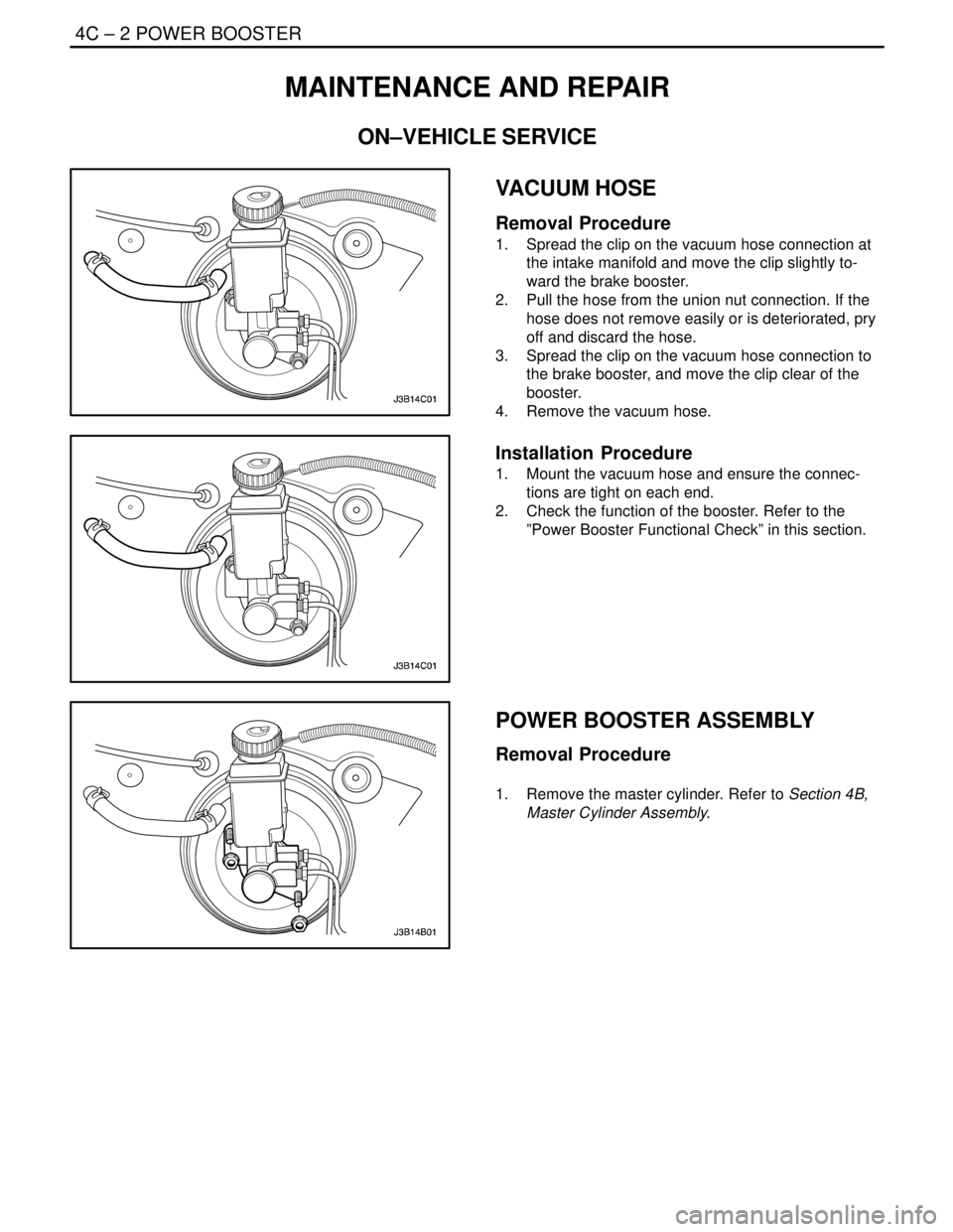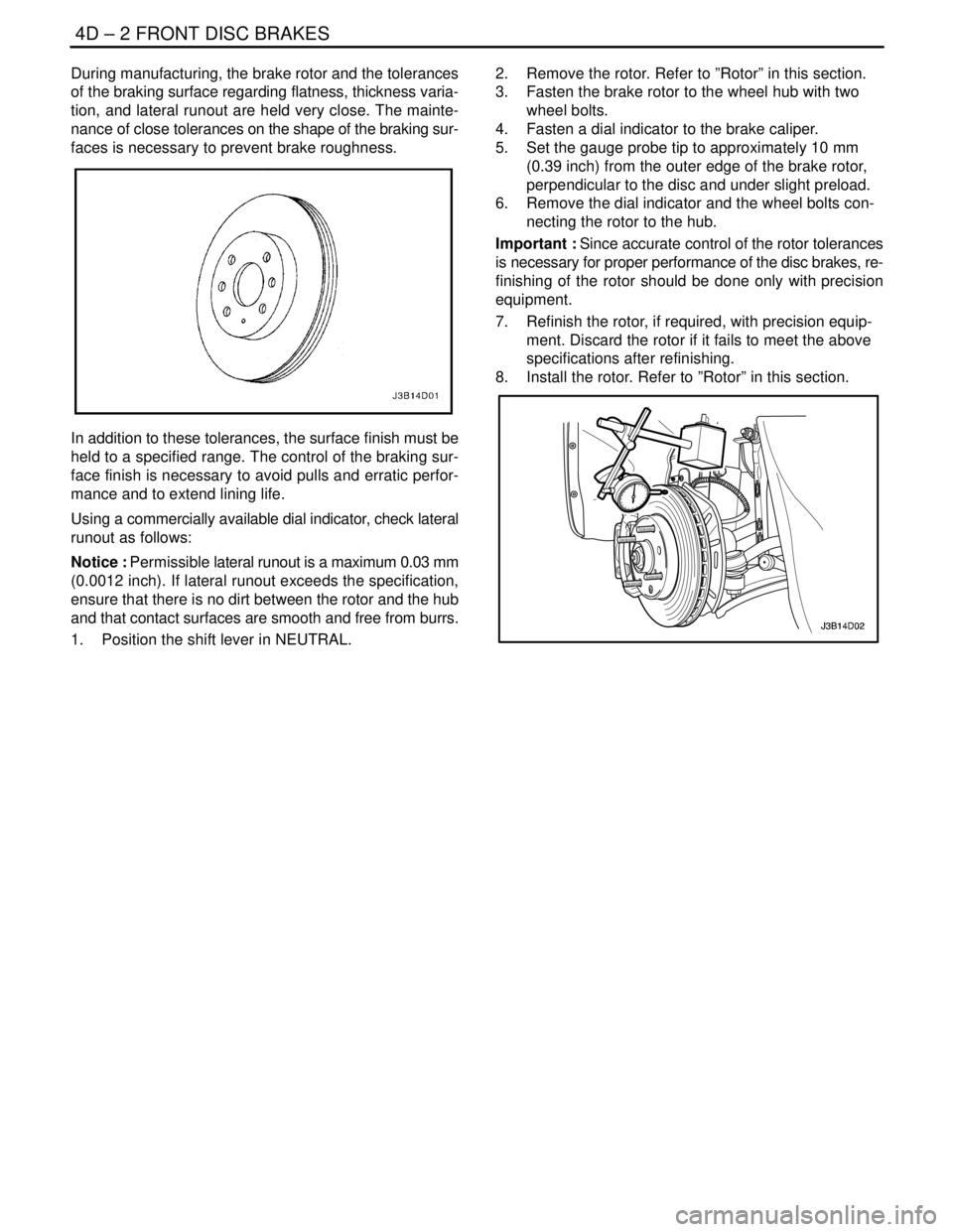2004 DAEWOO LACETTI light
[x] Cancel search: lightPage 1014 of 2643

4–2WUSAGE AND CAPACITY OF FUSES IN FUSE BLOCK
1. ENGINE ROOM RELAY AND FUSE BLOCK
1) POSITION OF RELAY AND FUSE
2) USAGE OF FUSE IN ENGINE FUSE BLOCK
Power
Supply
ClassificationFuse
NoCapacityUsage
Ef130ABattery Main(F13~F16, F21~F24)
Ef260AEBCM, Oil Feeding Conenctor
Ef330ABlower Relay
30SBEf430AIgnition Switch–2
BAT (+)(Slow–BlownEf530AIgnition Switch–1
Fuse)Ef620ACooling Fan Low Relay
Ef730ADefog Relay
Ef830ACooling Fan HI Relay
IGN2 (15A)Ef920APower Window Switch
IGN1 (15)Ef1015AFuel Connector, ECM (MR–140), LEGR, EI
System
30Ef1110AECM, Main Relay (Sirius D4)
BAT(+)Ef1225AHead lamp Relay, ILLUM. Relay
Ef1315ABrake Switch
IGN2 (15A)Ef1420APower Window Switch
56 LIGHTEf1515AHead Lamp HI
30Ef1615AHorn Relay, siren, Hood Contact Switch
BAT(+)Ef1710AA/C Comp. Relay
IGN1 (15)Ef1815AFuel Pump
30 BAT(+)Ef1915ACluster, Key Remind S/W, Folding Mirror Unit, MAP
Lamp, Room Lamp, Trunk Open lamp, Trunk
Open S/W
56 LIGHTBlade TypeEf2010AHead Lamp Low
IGN1 (15)/FuseEf2115AEVAP Canister Purge Solenoid, HO2S, Cooling
Fan Relay
30 BAT(+)Ef2215Ainjector, EGR, EEGR
ILLUM. (58)Ef2310ALicense Plate Lamp, Chime Bell, Tail Lamp, Head
Lamp
30 BAT (+)Ef2415AFog Lamp Relay
IGN2 (15A)Ef2510AElectric OSRV Mirror
30 BAT (+)Ef2615ACentral Door Lock Unit
56 LIGHTEf2710AHead Lamp Low
ILLUM. (58)Ef2810AILLUM. Circuit, Head Lamp, Tail Lamp
SPAREEf2910ANot Used
Ef3015ANot Used
Ef3125ANot Used
Page 1015 of 2643

USAGE AND CAPACITY OF FUSES IN FUSE BLOCKW4–3
2. I.P FUSE BLOCK
1) POSITION OF FUSE AND RELAY
2) USAGE OF FUSE IN I.P FUSE BLOCK
Power
Supply
ClassificationFuse
NoCapacityUsage
IGN1 (15)Blade TypeF110ASDM
FuseF210ATCM, ECM, Generator, VGIS,VSS
F315AHazard Switch
F410ACluster, Chime Bell, Brake Switch, SSPS Module,
A/C Control Switch
–F5––
IGN2 (15A)F610AA/C Comp. Relay, Defog Relay, Power Window
Relay, Head Lamp Relay
F720ABlower Relay, A/C Control Switch, FATC
F815AElectric Mirror Switch, Folding Mirror, Sun Roof
Module
IGN1 (15)F925AWiper Motor, Wiper Switch
–F10––
IGN1 (15)F1110AEBCM, Oil Feeding Connector
F1210AImmobilizer, Anti Theft Control Unit, Rain Sensor
Unit
30 BAT(+)F1310ATCM
F1415AHazard Switch
F1515AAnti Theft Control Unit
F1610ADLC
ACC (15C)F1710AAudio, Clock
F1815AExtra Power Jack
F1915ACigar Lighter
IGN1 (15)F2010AReverse Lamp Switch, PNP Switch
30 BAT(+)F2115ARear Fog Relay
F2215AClock, FATC, A/C Control Switch
F2315AAudio
F2410AImmobilizer
Page 1021 of 2643

HYDRAULIC BRAKES 4A – 5
DAEWOO V–121 BL4
DIAGNOSIS
BRAKE SYSTEM TESTING
Brakes should be tested on a dry, clean, reasonably
smooth and level roadway. A true test of brake perfor-
mance cannot be made if the roadway is wet, greasy, or
covered with loose dirt whereby all tires do not grip the
road equally. Testing will also be adversely affected if the
roadway is crowned so as to throw the weight so roughly
that the wheels tend to bounce.
Test the brakes at different vehicle speeds with both light
and heavy pedal pressure; however, avoid locking the
brakes and sliding the tires. Locked brakes and sliding
tires do not indicate brake efficiency since heavily braked,
but turning, wheels will stop the vehicle in less distance
than locked brakes. More tire–to–road friction is present
with a heavily–braked, turning tire than with a sliding tire.
Because of the high deceleration capability, a firmer pedal
may be felt at higher deceleration levels.
There are three major external conditions that affect brake
performance:
S Tires having unequal contact and grip of the road
will cause unequal braking. Tires must be equally
inflated, and the tread pattern of the right and the
left tires must be approximately equal.
S Unequal loading of the vehicle can affect the brake
performance since the most heavily loaded wheels
require more braking power, and thus more braking
effort, than the others.
S Misalignment of the wheels, particularly conditions
of excessive camber and caster, will cause the
brakes to pull to one side.
To check for brake fluid leaks, hold constant foot pressure
on the pedal with the engine running at idle and the shift
lever in NEUTRAL. If the pedal gradually falls away with
the constant pressure, the hydraulic system may be leak-
ing. Perform a visual check to confirm any suspected
leaks.
Check the master cylinder fluid level. While a slight drop
in the reservoir level results from normal lining wear, an ab-
normally low level indicates a leak in the system. The hy-
draulic system may be leaking either internally or external-
ly. Refer to the procedure below to check the master
cylinder. Also, the system may appear to pass this test
while still having a slight leak. If the fluid level is normal,
check the vacuum booster pushrod length. If an incorrect
pushrod length is found, adjust or replace the rod.
Check the master cylinder using the following procedure:
S Check for a cracked master cylinder casting or
brake fluid leaking around the master cylinder.
Leaks are indicated only if there is at least one drop
of fluid. A damp condition is not abnormal.S Check for a binding pedal linkage and for an incor-
rect pushrod length. If both of these parts are in
satisfactory condition, disassemble the master cyl-
inder and check for an elongated or swollen primary
cylinder or piston seals. If swollen seals are found,
substandard or contaminated brake fluid should be
suspected. If contaminated brake fluid is found, all
the components should be disassembled and
cleaned, and all the rubber components should be
replaced. All of the pipes must also be flushed.
Improper brake fluid, or mineral oil or water in the fluid,
may cause the brake fluid to boil or cause deterioration of
the rubber components. If the primary piston cups in the
master cylinder are swollen, then the rubber parts have
deteriorated. This deterioration may also be evidenced by
swollen wheel cylinder piston seals on the drum brake
wheels.
If deterioration of rubber is evident, disassemble all the hy-
draulic parts and wash the parts with alcohol. Dry these
parts with compressed air before reassembly to keep alco-
hol out of the system. Replace all the rubber parts in the
system, including the hoses. Also, when working on the
brake mechanisms, check for fluid on the linings. If exces-
sive fluid is found, replace the linings.
If the master cylinder piston seals are in satisfactory condi-
tion, check for leaks or excessive heat conditions. If these
conditions are not found, drain the fluid, flush the master
cylinder with brake fluid, refill the master cylinder, and
bleed the system. Refer to ”Manual Bleeding the Brakes”
or”Pressure Bleeding the Brakes” in this section.
BRAKE HOSE INSPECTION
The hydraulic brake hoses should be inspected at least
twice a year. The brake hose assembly should be checked
for road hazard damage, cracks, chafing of the outer cov-
er, and for leaks or blisters. Inspect the hoses for proper
routing and mounting. A brake hose that rubs on a suspen-
sion component will wear and eventually fail. A light and
a mirror may be needed for an adequate inspection. If any
of the above conditions are observed on the brake hose,
adjust or replace the hose as necessary.
WARNING LAMP OPERATION
This brake system uses a BRAKE warning lamp located
in the instrument panel cluster. When the ignition switch
is in the START position, the BRAKE warning lamp should
glow and go OFF when the ignition switch returns to the
RUN position.
The following conditions will activate the BRAKE lamp:
S Parking brake applied. The light should be ON
whenever the parking brake is applied and the igni-
tion switch is ON.
S Low fluid level. A low fluid level in the master cylin-
der will turn the BRAKE lamp ON.
S EBD system is disabled. The light should be ON
when the EBD system is malfunctioning.
Page 1024 of 2643

4A – 8IHYDRAULIC BRAKES
DAEWOO V–121 BL4
StepNo Yes Value(s) Action
16Check for a short to ground in the wiring between the
instrument cluster terminal A19(B15) and the EBCM
connector terminal 21.
Is the problem found?–Go to Step 17Go to Step 18
17Repair the wiring as needed.
Is the repair complete?–System OK–
18Check the brake lamp after doing each of the follow-
ing functions:
S Apply the parking brake.
S Remove the cap from the brake fluid reservoir.
S On vehicles equipped with ABS, command the
lamp on using a scan tool.
Does the brake warning lamp operate for all of these
conditions?–System OKGo to Step 19
19When the operations listed in step 18 were per-
formed, the brake warning lamp did not function.
Did the brake warning lamp fail to light for all of the
operations listed in step 18?–Go to Step 20Go to Step 27
201. Turn the ignition OFF.
2. Inspect the kick panel fuse F4.
Is the fuse OK?–Go to Step 22Go to Step 21
21Replace the fuse.
Is the repair complete?–System OK–
22Inspect the brake warning lamp bulb.
Is the bulb OK?–Go to Step 24Go to Step 23
23Replace the bulb.
Is the repair complete?–System OK–
241. Disconnect the instrument cluster connector.
2. Turn the ignition ON.
3. Measure the voltage at the instrument cluster
connector terminal A19(B15).
Does the voltage measure within the value speci-
fied?11–14 vGo to Step 25Go to Step 26
251. Turn the ignition OFF.
2. Repair the open in the instrument cluster.
Is the repair complete?–System OK–
261. Turn the ignition OFF.
2. Repair the open in the wiring between the in-
strument cluster connector terminal A19(B15)
and the ignition switch.
Is the repair complete?–System OK–
27Apply the parking brake again.
Does the parking brake warning lamp operate with
the parking brake applied?–Go to Step 28Go to Step 30
28Remove the brake fluid reservoir cap.
Does the parking brake warning lamp operate with
the cap from the brake fluid reservoir removed?–Go to Step 29Go to Step 32
29Check for an open between the instrument cluster
connector terminal A1 and the EBCM connector ter-
minal 21.
Is the problem found?–Go to Step 17Go to Step 13
Page 1025 of 2643

HYDRAULIC BRAKES 4A – 9
DAEWOO V–121 BL4
StepNo Yes Value(s) Action
301. Turn the ignition ON.
2. Disconnect the parking brake switch.
3. Jumper the parking brake switch connector
terminal to ground.
Is the lamp on?–Go to Step 10Go to Step 31
311. Turn the ignition OFF.
2. Repair the open in the wire between the instru-
ment cluster connector terminal A1 and the
parking brake switch connector terminal.
3. Is the repair complete?
Is the repair complete?–System OK–
321. Disconnect the brake fluid level switch.
2. Turn the ignition ON.
3. Jumper the brake fluid level switch connector
terminals.
Is the lamp on?–Go to Step 8Go to Step 33
331. Turn the ignition OFF.
2. Connect a test light between battery positive
and the BRN/WHT wire terminal of the brake
fluid level switch.
Is the test light on?–Go to Step 34Go to Step 35
34Repair the open in the wiring between ground and
the brake fluid level switch.
Is the repair complete?–System OK–
35Repair the open in the wiring between the instrument
cluster connector terminal A1 and the brake fluid lev-
el switch.
Is the repair complete?–System OK–
Page 1042 of 2643

MASTER CYLINDER 4B – 9
DAEWOO V–121 BL4
GENERAL DESCRIPTION
AND SYSTEM OPERATION
MASTER CYLINDER
The master cylinder is designed for use in a diagonal–split
system. One front and one diagonally opposite rear brake
are served by the primary piston. The opposite front and
rear brakes are served by the secondary piston. The mas-
ter cylinder incorporates the functions of the standard dual
master cylinder, plus a low fluid level indicator and the pro-
portioning valves in the non–antilock braking system. The
proportioning valves limit the outlet pressure to the rear
brakes after a predetermined master cylinder pressure
has been reached.
Important :
S Replace all the components included in the repair
kits used to service this master cylinder.S Lubricate rubber parts with clean brake fluid to ease
assembly.
S Do not use lubricated shop air on brake parts, as
this may damage rubber components.
S If any hydraulic component is removed or discon-
nected, it may be necessary to bleed all or part of
the brake system.
S The torque values specified are for dry, unlubri-
cated fasteners.
S Perform all service operations on a clean bench,
free from all traces of mineral oil.
FLUID LEVEL SENSOR
The master cylinder is equipped with a fluid level sensor.
This sensor will activate the BRAKE light if a low fluid level
condition is detected. Once the fluid level is corrected, the
BRAKE light will go out.
Page 1044 of 2643

4C – 2IPOWER BOOSTER
DAEWOO V–121 BL4
MAINTENANCE AND REPAIR
ON–VEHICLE SERVICE
VACUUM HOSE
Removal Procedure
1. Spread the clip on the vacuum hose connection at
the intake manifold and move the clip slightly to-
ward the brake booster.
2. Pull the hose from the union nut connection. If the
hose does not remove easily or is deteriorated, pry
off and discard the hose.
3. Spread the clip on the vacuum hose connection to
the brake booster, and move the clip clear of the
booster.
4. Remove the vacuum hose.
Installation Procedure
1. Mount the vacuum hose and ensure the connec-
tions are tight on each end.
2. Check the function of the booster. Refer to the
”Power Booster Functional Check” in this section.
POWER BOOSTER ASSEMBLY
Removal Procedure
1. Remove the master cylinder. Refer to Section 4B,
Master Cylinder Assembly.
Page 1050 of 2643

4D – 2IFRONT DISC BRAKES
DAEWOO V–121 BL4
During manufacturing, the brake rotor and the tolerances
of the braking surface regarding flatness, thickness varia-
tion, and lateral runout are held very close. The mainte-
nance of close tolerances on the shape of the braking sur-
faces is necessary to prevent brake roughness.
In addition to these tolerances, the surface finish must be
held to a specified range. The control of the braking sur-
face finish is necessary to avoid pulls and erratic perfor-
mance and to extend lining life.
Using a commercially available dial indicator, check lateral
runout as follows:
Notice : Permissible lateral runout is a maximum 0.03 mm
(0.0012 inch). If lateral runout exceeds the specification,
ensure that there is no dirt between the rotor and the hub
and that contact surfaces are smooth and free from burrs.
1. Position the shift lever in NEUTRAL.2. Remove the rotor. Refer to ”Rotor” in this section.
3. Fasten the brake rotor to the wheel hub with two
wheel bolts.
4. Fasten a dial indicator to the brake caliper.
5. Set the gauge probe tip to approximately 10 mm
(0.39 inch) from the outer edge of the brake rotor,
perpendicular to the disc and under slight preload.
6. Remove the dial indicator and the wheel bolts con-
necting the rotor to the hub.
Important : Since accurate control of the rotor tolerances
is necessary for proper performance of the disc brakes, re-
finishing of the rotor should be done only with precision
equipment.
7. Refinish the rotor, if required, with precision equip-
ment. Discard the rotor if it fails to meet the above
specifications after refinishing.
8. Install the rotor. Refer to ”Rotor” in this section.